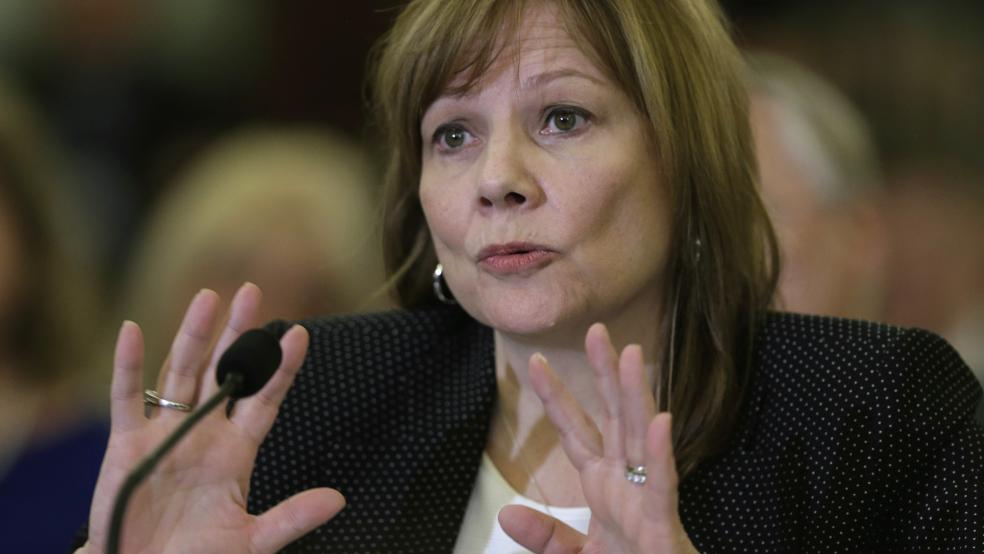She of course had little choice but to appear, but General Motors CEO Mary T. Barra’s two days of often clumsy and fuzzy congressional testimony last week on GM’s recall of 2.6 million Chevrolet Cobalts and other compact cars continues to haunt Barra and her embattled auto manufacturer.
A serious defect in the ignition switch that could shut off the car’s power and prevent air bags from deploying in the event of a crash was covered up by the company for more than a decade before GM fully disclosed the problem and began issuing recalls for the defective cars in February. The defect is now blamed on at least 13 deaths and 31 crashes in small cars from mostly the 2003 through 2007 model years.
Related: GM CEO Says She Doesn’t Know Why It Took So Long to Fix the Ignition
NBC’s “Saturday Night Live” spoofed Barra’s efforts to distinguish the engineering sins of the “old GM” that operated before the company’s 2009 bankruptcy and federal bailout with the “new” GM, as well as Barra’s repeated refusal to answer lawmakers’ tough questions until the company’s internal investigation has been completed.
“I represent the new GM, and the new GM is all about honesty and transparency," the Barra character declares, but then responds to every hard-hitting question with, "We are looking into that."
When asked about GM's checkered history of defective cars, all Barra would say was, "The first rule about new GM is you never talk about old GM."
Then on Sunday, Sen. Claire McCaskill (D-MO), the chair of a Senate Commerce, Science and Transportation subcommittee who grilled Barra last week was still fuming about GM’s deceptive practices. In particular, she was outraged that GM engineers and managers quietly replaced the defective ignition switch in 2007 without notifying the public and federal regulators and without changing the serial number of the part to show it was new.
Related: Lawmakers See Massive Breakdown at NHTSA in GM Recall
“There is no reason to keep the same part number unless you're trying to hide the fact that you've got a defective switch out there that in fact ended up killing a number of people on our highways,” McCaskill said on the ABC News program “This Week With George Stephanopoulos.”
Although Barra, a 33-year veteran of GM, once headed the global engineering division, she could not speak with any certainty about the decision-making when GM first approved the flawed ignition switch design back in 2002. Nor did she know much about a March 2005 decision against redesigning the ignition switch because it wasn’t deemed a sound business practice by engineers. She was also in the dark about GM’s decision to quietly change the ignition switch design in 2007 without informing consumers or regulators about the significant development.
Ray DeGiorgio, the chief switch engineer on the Cobalt, was confronted in a sworn deposition with the differences between the original switch and the replacement by a lawyer representing the family of a driver killed in one of the cars, according to The New York Times. While DeGiorgio said he saw the differences, he said that he could not explain why the part had been changed and that he had not approved it.
In a document, however, DeGiorgio signed off on the change, which increased the force required to turn the ignition switch. The document is dated April 26, 2006. DeGiorgio gave the sworn deposition a year ago, in the case of the death of Brooke Melton, in 2010 near Atlanta.
Related: How a Watchdog Blew the Lid Off the GM Recall Scandal
“It is possible that these engineers were so interested in covering themselves, especially this Mr. Ray DeGiorgio who perjured himself a number of times in his deposition -- he lied over and over again,” McCaskill said today. “Because afterwards, we found the document where he signed off on the changes, a document which was never given to the lawyers in that case, by the way.”
Asked whether Congress would attempt to force the company to compensate the families of victims even though GM technically is protected from lawsuits brought involving negligence and wrongdoing occurring before GM filed for bankruptcy in 2009, McCaskill replied, “Well, I think this is a real moment of truth for General Motors. They've tried to lawyer up and play whack-a-mole with these lawsuits and terrible things have happened. Now it's time for them to come clean, be transparent and most of all make all victims whole no matter when this deadly ignition caused heartbreak in their families.”
Related: GM Ignition Switch Fix Would Have Cost Less Than $1 Apiece
During her two days of testimony last week before House and Senate panels, the new chief of GM was apologetic, contrite and seemed earnest in her commitment to unveil the mystery surrounding the long-delayed recall. She signaled an interest in working out settlements with the families of victims by announcing that her company had retained attorney Kenneth Feinberg – who negotiated the federal government’s settlement with families of the victims of the 911 terrorist attacks -- to work on the recall case.
Yet, her performance was almost universally panned by lawmakers and auto safety watchdogs who thought she either was being evasive or came ill prepared for the detailed questions many wanted answered. Because only a relatively small audience viewed the two days of CSPAN coverage of the testimony of Barra and National Highway Transportation Safety Administration chief David J. Friedman, many Americans will likely base their opinions of Barra on the “Saturday Night Live” skit.
Top Reads from The Fiscal Times:





